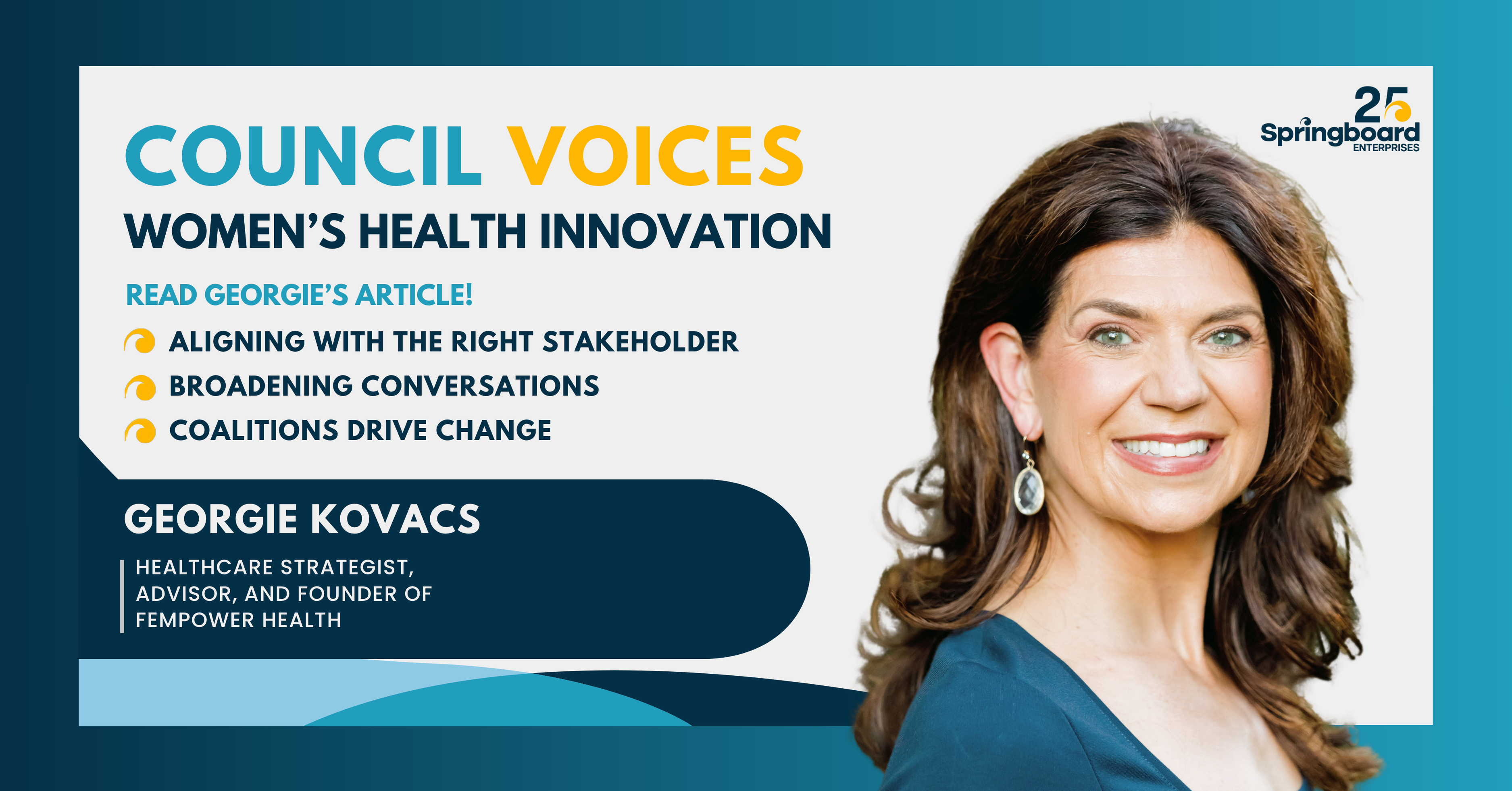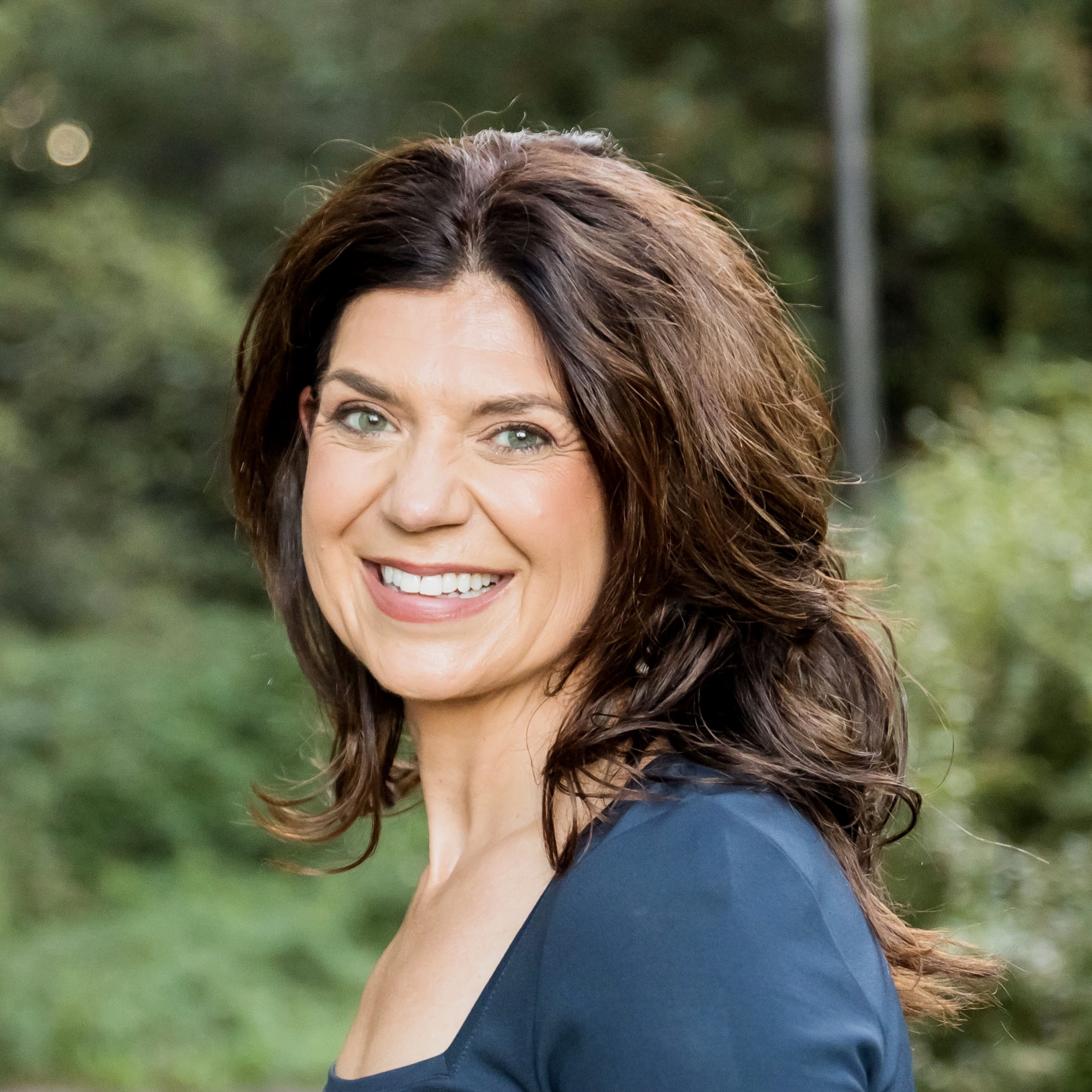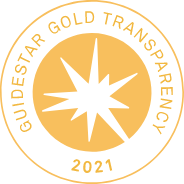
Georgie Kovacs
From Awareness to Alignment: The Next Imperative
in Women’s Health Innovation
We’ve spent the last few years widening the lens on what “women’s health” really means. Thanks to a series of recent reports from WHAM, World Economic Forum (WEF) & McKinsey Health Institute, Silicon Valley Bank (SVB), and others, we have finally driven the conversation beyond reproduction and menopause to be a more representative definition of the health of women – diseases that affect women disproportionately, differently, or uniquely. These diseases include endometriosis, cardiovascular disease, autoimmune disease, Alzheimer’s disease and more.
The landscape is evolving beyond apps and telehealth into diagnostics and therapeutics—signaling a deeper commitment to clinical impact. This shift is long overdue. But despite that progress, there’s a growing sense of stagnation. In one-on-one conversations and small meetings, we talk about it: the same headlines, the same panels, the same data points across decks, keynotes, and podcasts. Add to this plateau the recent administration’s ping-ponging on funding decisions—like with the Women’s Health Initiative—and the momentum feels uncertain.
How do we move the needle? The good news is: there are clear ways forward. Even better, many individuals and organizations are already laying the groundwork for meaningful change.
But to accelerate that progress—and avoid repeating the same conversations—we each need to take ownership. Whether founder, investor, policymaker, clinician, or advocate, everyone in this space has a role to play.
This piece outlines three key paths to drive lasting impact in women’s health:
- Understanding and aligning with the right stakeholders
- Expanding the rooms—and the conversations—we’re having
- Building coalitions that go beyond performance and into coordinated action
And while there’s still work to be done, it’s important to recognize the forward momentum already underway.
Let’s break it down.
The Role We Can Each Play
Founders: Pitch to the Right People—and Pitch Differently Every Time
Beyond building a great team and securing product-market fit, founders face one constant pressure: raising the capital to fund and scale the business. And the data is sobering. According to NASDAQ, in 2024, women’s health companies received only 2.3% of total healthcare venture capital funding, a significant drop from 2023’s record-high of 4.1%. It’s a frustrating statistic, and it’s one we can’t afford to accept as the norm.
In my time on the Springboard Enterprises Council—and throughout my work in women’s health—I’ve observed a few dynamics that might help move the needle on this troubling statistic. At the core of it all is one truth: know your stakeholder. Start with your story—but don’t stop there. Know what your audience values, and guide them toward your vision in terms they can understand.
So what does that actually look like in practice?
The first observation is that most founders in this space are driven by passion and personal experience. And understandably so—women’s health has been historically underfunded, under-researched, and misunderstood. Add to that the complexity of the healthcare system and a legacy of misogyny, and of course it’s women who are leading the charge.
While investors may appreciate a passionate, mission-driven team, their lens is different. Their focus is on return and risk. A compelling founding story is a powerful starting point—but to secure funding, founders need to show investors how they’ll achieve their goals, too.
I’ve lived this disconnect. When I launched Fertility for Me, a platform designed to improve the fertility journey, I pitched three white male investors over the age of 65. One of them asked, “What do you mean people have a problem with fertility?” Despite being part of an incubator, I was completely dismissed.
Frustrated, I overcorrected—leading with the raw emotion of my four-year fertility struggle. While people listened, they focused on the trauma and missed the business plan. It wasn’t until I reframed the story around the economics of fertility—the actual business opportunity—that I advanced in the competition.
That leads to the next observation: founders need to find the right investors and speak their language. A successful pitch isn’t about what you want to say—it’s about what your audience needs to hear.
Founders must act as a matchmaker for how the potential investor’s investment thesis might match the startup’s funding requirements, business model, and sector. The closer the match, the better.
Conduct a deep dive on the potential investor to shape the company’s story, layered on top of the investor’s basic needs – ROI and exit strategy. Questions to consider:
- How much do they understand this disease area?
- Which data and proof points will they need to have confidence in the company’s future?
- Does the company have a strong team who can deliver on its promises?
- Regardless of the company’s vision, what does the investor need to hear to trust and have confidence in the company?
Each pitch must be customized for a given investor.
Separately, consider thinking out of the box. My favorite story is that of Aunt Flow, run by the brilliant Claire Coder. While her business is access to free menstrual products in every bathroom, her customers are often the facilities teams and thus, her investors are not necessarily healthcare investors. It’s a reminder that customers—and investors—may live outside traditional categories. If you understand your stakeholders deeply, you can find alignment in unexpected places.
When we tailor our pitch to the right stakeholders, we increase our chances of being heard. But that’s only half the equation. We also need to ask: who’s even in the room? Because the truth is, we’re often delivering powerful ideas to the same small circle—and wondering why broader momentum is so hard to build.
The Echo Chamber Problem: If the Room Looks the Same, the Outcome Will Be Too
We’re not just recycling stats—we’re recycling audiences. Too many of the people leading this conversation are talking to each other whether at conferences or on social media (thank you algorithms). I don’t say that with judgment—I say it with concern, and I’m not the only one.
Across most women’s health events, the audience skews overwhelmingly female. Most clinicians already agree with and have lived experiences around the challenges in women’s health. Investors who focus on women’s health already believe in and know the space. While that creates solidarity, it doesn’t create momentum.
Where are the generalist VCs? Where are the payers? Where are the regulators? Most importantly, where are the men?
This work doesn’t move forward unless the rooms change. We need to be thoughtful about who we invite into these conversations—not just symbolically, but meaningfully. Because if the only people shaping the future of women’s health are the ones already convinced it matters, we’re not going to reach the scale or credibility this work deserves.
In addition to having the right audience, the discussions need to change. Rather than sharing the statistics, highlight meaningful success (beyond praise for successful funding rounds) and hold roundtables to discuss solutions to specific problems led by experts outlining a clear plan.
Changing the audience is a start. Changing the conversation is even better. But if we really want to drive impact in women’s health, we have to go beyond individual voices and isolated wins. We need to align. And that requires something many sectors talk about—but few execute well: true coalition.
Coalition is Not a Buzzword. It’s the Strategy.
We don’t have time to wait 17 years for research to translate into care. We’re owed centuries of data, as Dr. Lisa Mosconi, a neuroscientist and women’s brain health specialist, says—and yet we’re still trying to get funding for the basics.
So what’s working? Where have other fields succeeded?
- Alzheimer’s Disease: Lisa Mosconi’s work is rallying scientists, funders, and policymakers around a sex-specific research agenda.
- Breast Cancer: That wasn’t just a research story—it was a communications strategy, a funding movement, a cultural shift.
- Tuberculosis: Global alignment, clear data, and political will made it a case study in public health coordination.
What do they have in common?
- Shared agendas
- Long-term commitment
- Stakeholders who know how to align around a cause even when their incentives don’t naturally overlap
We have examples. We don’t need to start from scratch. But we do need to start organizing with more clarity and less performance. Thankfully, some of that alignment is already beginning to take shape. Across the women’s health ecosystem, we’re seeing real momentum—organizations, advocates, and investors stepping up in meaningful ways.
Acknowledging Forward Momentum
We’re not short on effort. In fact, there’s incredible work being done across the women’s health ecosystem right now.
- Organizations like Springboard Enterprises provide startups access to leading experts, optimizing the success of their business.
- Women’s Health Advocates focuses on educating the government and advocating for policies and funding needed to advance the health of women.
- Women’s Health PAC is pushing forward a non-partisan, membership-based organization to support women’s health across research, policy, candidates, and more.
- Venture funds such as Foreground Capital and Portfolia prioritize investing in women’s health.
Final Thought
Everyone I know in this space is working hard. This isn’t a critique of effort or intellect or drive. Instead, it’s an invitation to pause and ask: Are we being as strategic as we are passionate? Because passion got us here. Strategy is what gets us further. And that starts by asking not just, “What do I want to say?”—but,
“Who needs to hear it—and how do I help them understand why it matters?” That’s where real change begins.
We’ve broadened the lens. Now it’s time to change the view.
And that starts by understanding who we’re speaking to—and why they haven’t joined the conversation yet.
Georgie Kovacs is a healthcare strategist, advisor, and founder of Fempower Health, a platform dedicated to reshaping the conversation on women’s health. With over 20 years of experience in biopharma, consulting, and healthcare innovation—spanning roles at Pfizer, Syneos Health, IQVIA, and Bristol-Myers Squibb—she bridges the gap between research, patient needs, and industry strategy.
Georgie is a member of the Springboard Enterprises Women’s Health Council, where she helps select and mentor startups innovating in women’s health. Through Fempower Health, she has interviewed top experts, translating complex healthcare challenges into actionable insights. Her work has been featured in CBS This Morning, GoodRx, Authority Magazine, and the Endometriosis Foundation of America.



